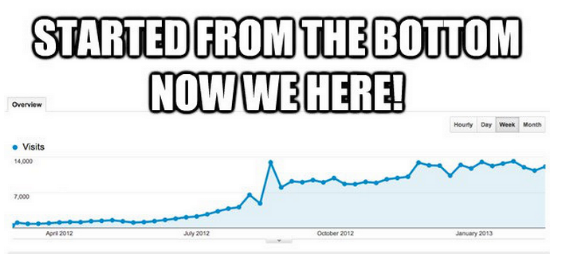There’s no easy path to pleasing the great search engine algorithm in the sky but here’s a few proven tips.
Yes there are proven ways to provide what Google wants so you can rank higher for the long term. Follow these suggestions, and watch your website rise the ranks to the top of search-engine results.
It’s more important than ever that you produce consistent quality content and make that content be topic as well as keyword focused in order to rank at the top of Google search engine results.
Here are six ways you can move with the advancing trends of Google’s search engine this year and beyond.
1. Focus on content topics (not just keywords) and user experience
Keywords are still pertinent now more than ever when it comes to landing top search engine rankings, but Google is now placing much more importance on quality, relevance, and contextual content.
In the past, a mediocre body of text filled with keywords could easily snag decent rankings, but this type of content doesn’t perform well anymore.
Google wants great, unique content that is useful to readers.
Your site should be easy to navigate and consume. This not only keeps visitors on your website, but it helps these same visitors build a stronger bond of trust with Google.
Rankings are just one part of the equation. Question based, inbound traffic with higher engagement and conversions are the key areas to work on this year.
Quality content is the number one driver of your search engine rankings and there is no substitute for great content. Quality content created specifically for your intended user increases site traffic, which improves your site’s authority and relevance.
Identify a keyword phrase for each page. Think about how your reader might search for that specific page (with phrases like “best las vegas restaurants,” “best japanese noodle house,” or “best sushi on the vegas strip”). Then, repeat this phrase several times throughout the page—once or twice in the opening and closing paragraphs, and two to four more times throughout the remaining content.
Don’t forget to use bold, italics, heading tags, and other emphasis tags to highlight keyword phrases, but don’t overdo it.
Never sacrifice good writing for SEO. The best pages are written for the user, not for the search engine.
2. Ensure that your website is mobile-friendly.
Users are accessing portable and mobile devices more than ever to browse and search the web.
Mobile usage comprise so much of overall online traffic that Google may already be ‘penalizing’ websites that return mobile errors.
Building a mobile-friendly website not only satisfies Google, but it will bode well for your mobile traffic and overall site engagement.
And, for your geographic business region, Local SEO and mobile optimization is a must-implement strategy.
You’ve probably noticed that we keep talking about content. Search engines do, too. Regularly updated content is viewed as one of the best indicators that a site is topical and relevant, so be sure to keep it fresh.
3. Embrace Metadata
When designing your website, each page contains a space between the <head> tags to insert metadata, or information about the contents of your page. If you have a CMS (code management system) controlled site, much of this data is already populated for you:
- Title metadata is responsible for the page titles displayed at the top of a browser window. It is the most important metadata on your page. For those with a CMS website, there is typically an automated system for creating the meta title for each web page.
- Description metadata is the textual description that a browser will use in your page search return. Think of it as your site’s window display—a concise and appealing description of what is contained within, with the goal of encouraging people to enter.
- Keyword metadata are the search phrases that people type when they want to find your page. You’ll want to include a variety of phrases. However, don’t get greedy: if your list becomes excessive, the browser may completely ignore the data. As a general rule, try to keep it to about 6-8 phrases with each phrase consisting of 1-4 words. A great example would be “las vegas best steak restaurants.”
Always describe your visual and video media using alt tags, or alternative text descriptions. They allow search engines to locate your page, which is crucial—especially for those who use text-only browsers.
4. Use the “Disavow Tool” offered by Google (carefully)
Website owners and marketing professionals are noticing that Google is placing a stronger penalization on websites that are associated with “spammy” websites.
As you continue to assess your possible “Penguin”, “RankBrain”, “Adwords Shake-up” and another algorithm update impacted factors, it is imperative that you start with an outreach program to those website owners.
After requesting to have them removed, you can use Google’s “Disavow Tool” to begin disassociating the remaining items that taint your website or pages with bad links and poor neighborhood trust.
5. Keep building links (and build them at a ‘natural’ pace)
Websites that are linked to by other sites that Google classifies as “good” will always see positive reception from the Google search engine algorithm.
However, the as you’ve learned, Google has always cracked down on unnatural link-building strategies. It’s still okay to build a thorough link-building plan and execute it, but you should ensure that you deploy it at a natural rate.
Focus on creating relevant links within the text. Instead of having “click here” links, try writing out the name of the destination. “Click here” has no search engine value beyond the attached URL, whereas “Top Las Vegas Entertainment Destination” is rich with keywords and will improve your search engine rankings as well as the ranking of the page you are linking to.
6. Lastly, make your content shareable.
Sharing content on social media platforms (Facebook, Twitter, LinkedIn) is big now, and it’s important that your target market would want to share yours.
As your content gets more sharing and distribution, you’ll begin to gain more traffic and visibility. In turn, this leads to more natural links from genuine websites and sources.
Social signals appear to have an indirect effect on Google search, and specifically when considering engagement, which is increasingly becoming important.
Overall, it’s a great strategy to cater to social media users. Learn more about what Malcolm Gladwell calls “Connectors, Mavens and Salesmen”, and the importance they can have in your social outreach programs.
Thanks for reading!



One comment
Hello,
Well, I have been trying out to understand Google Panda and Penguin, by reading more and more and this is helping me a lot. I know Google Panda is all about Quality Content.
Although, It would take some time for me to understand, How to avoid any penalty from Google Penguin. It is bit complicated for me, they say, Only natural links are safe, but After reading articles, including this one, i get bit confused.
Anyways, Will try experimenting a bit.